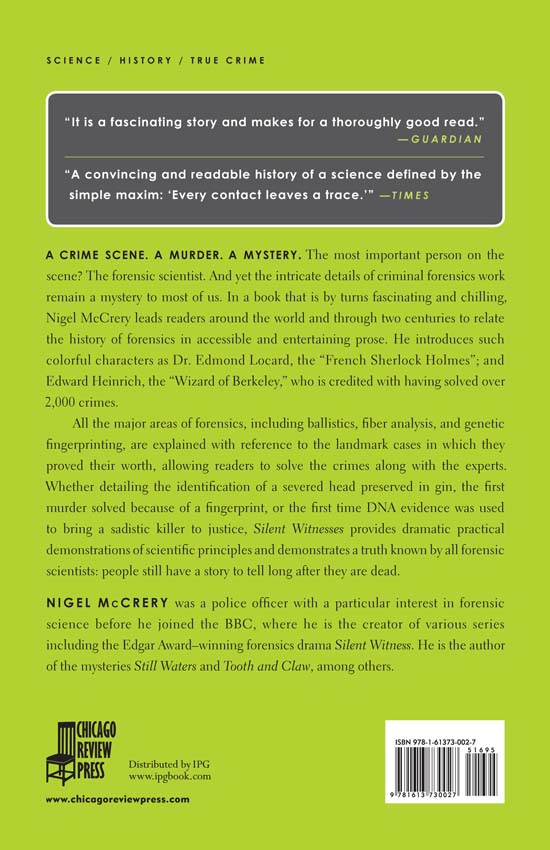Silent Witnesses (33 page)
Authors: Nigel McCrery

Finally it is worth looking at a case that demonstrates better than any other the capacity for DNA evidence to exonerate the innocent. It should surely give pause to advocates of the death penalty, since it demonstrates beyond doubt that miscarriages of justice do occur in such cases.
In 1984 a nine-year-old girl named Dawn Hamilton was raped and murdered in Rosedale, Maryland. A former marine named Kirk Noble Bloodsworth was arrested and charged with the crime, the main evidence against him being several eyewitnesses who placed him with or near Dawn around the time of her murder. The prosecution also maintained that footprints found on the victim's body matched a pair of shoes found in Bloodsworth's home. He steadfastly protested his innocence, but in 1985 he was found guilty and sentenced to death. Luckily, in 1986 it was discovered that the prosecution had illegally withheld evidence from the defense, and the Maryland court of appeal overturned the original conviction. When Bloodsworth was tried again he was found guilty once more,
but this time was sentenced to two terms of life imprisonment rather than death. This very possibly saved his life, as had he remained on death row, his sentence might well have been carried out before he had a chance to prove his innocence.
However, in 1992 Bloodsworth happened to read about the Black Pad murders and how DNA evidence had both eliminated an innocent man from the investigation and led to the capture of the real perpetrator. He immediately saw the potential of this new technology for his own case. Later that year, he succeeded in obtaining a court order for the testing to occur. Initially it looked as though this would be impossible, as the DNA evidence that existed from the caseâDawn Hamilton's underwear, which contained traces of semen from her attackerâcould not be found. Eventually, however, it was located in an evidence bag in the judge's office. The necessary analysis was carried out in Richmond, California, at Forensic Science Associates. The results completely exonerated Bloodsworth, and on June 28, 1993, he became the first death-row prisoner to be released on the basis of DNA evidenceâa wonderful forensic landmark. In 1995 the governor of Maryland, William Donald Schaefer, granted him a full pardon.
Ten years later, in the kind of extraordinary twist that we have by now come to expect in the world of forensics, additional DNA evidence that had been added to state and federal databases led to the identification of the real killer in 2003. He was a man named Kimberley Shay Ruffner who had in fact been incarcerated on unrelated attempted rape and assault charges just one month after Bloodsworth had been sentenced. Astonishingly, he was housed in a cell on the floor below Bloodsworth, and the two knew each other well; Ruffner
worked in the prison library and used to bring Bloodsworth his books. Ruffner was charged with Dawn Hamilton's murder and in 2004 pleaded guilty to the crime for which Bloodsworth had been wrongfully convicted. Bloodsworth was paid $300,000 in compensation and is now unsurprisingly a vocal supporter of measures such as the Innocence Protection Act, which seeks to minimize the risk of innocent people being executed.
The power of DNA fingerprinting is quite simply astonishingâparticularly when set against the early methods of identification described in this book. It is impossible to overstate the importance of DNA technology in the field of criminal investigation. To be able to definitively identify a person and link them to a crime scene is a power so striking that it seems almost fictionalâthe deductions of Sherlock Holmes and Hercule Poirot pale in comparison. To observe these techniques being used to reach back into history and solve mysteries that have remained unanswered for centuries only serves to underline the incredible potential of this technology.
In examining the history of forensic science, it is inevitable that we are forced to confront the darker side of human nature. We look at these brutal crimes and we say to ourselves in disbelief, “How could anyone do that?” I cannot disagreeâit is impossible not to look at such acts and see evil. But I hope that through explaining the complex and painstaking methods by which these crimes are solved, this book has also demonstrated that forensic science instantiates much of what is best in humanity: ingenuity, determination, and above all, a belief in justice.
Plate 3
© Everett Collection Historical / Alamy
Plate 6
© BSIP SA / Alamy
Plate 7
© Martin Phelps / Alamy
Plate 8
© Scenics and Science / Alamy
Plate 9
© Louise Murray / Alamy
Plate 10
© Mark Bourdillon / Alamy
Plate 11
© B Christopher / Alamy
Plate 12
© Mary Evans Picture Library / Alamy
Plate 13
© PARIS PIERCE / Alamy
Plate 14
© Mark Harvey / Alamy
Plate 15
© Archive Pics / Alamy
Figure 1 © The Print Collector / Alamy
Figure 2 © fStop / Alamy
Figure 4 © Art Directors & TRIP / Alamy
Figures 5, 7, 9, 12, 15, 19 © Alamy
Figure 10 © Old Paper Studios / Alamy
All other images courtesy of Wikimedia Commons.

